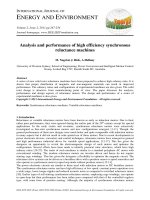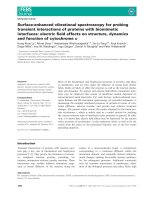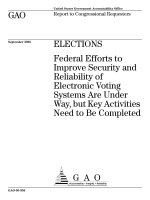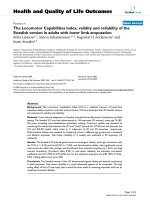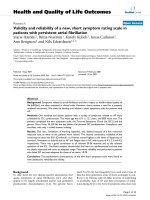Dynamics and reliability of access system of high density magnetic recording
Bạn đang xem bản rút gọn của tài liệu. Xem và tải ngay bản đầy đủ của tài liệu tại đây (4 MB, 200 trang )
DYNAMICS AND RELIABILITY OF ACCESS SYSTEM
OF HIGH DENSITY MAGNETIC RECORDING
HE ZHIMIN
NATIONAL UNIVERSITY OF SINGAPORE
2006
I dedicate this dissertation to my loving family.
Name: He Zhimin
Degree: Doctor of Philosophy
Department: Mechanical Engineering
Thesis Title: Dynamics and Reliability of Access System of High Density
Magnetic Recording
Abstract
To meet the continuous increase in demand for improved performances in the servo
mechanical system of magnetic recording access system, several novel structures for
the actuators/micro-actuators are proposed and their dynamic performances are
characterized through simulation, optimization, prototyping and experimental
investigations. These structures include: 1) a force coupled actuator to suppress the
lateral translational vibration motion mode; 2) a flexural pivot for use in disk drive
actuator to achieve a friction free and potentially cost-low design; 3) an actuator
assembly with small skew actuation; and 4) a split electrodes piezoelectric suspension
for dual-stage head positioning. This research also addresses the reliability evaluation
and lifetime estimation of the piezoelectric actuators by proposing a probabilistic
approach, i.e., P-E-N curve and the electric load-strength interference model. The
reliability model is further extended to a two-dimensional case to take into account
both electric driving voltage and temperature effects.
Keywords: magnetic recording, dynamics, access system, piezoelectric actuators,
probability, reliability
DYNAMICS AND RELIABILITY OF ACCESS SYSTEM
OF HIGH DENSITY MAGNETIC RECORDING
HE ZHIMIN
(M. Eng. NUS)
A THESIS SUBMITTED
FOR THE DEGREE OF DOCTOR OF PHILOSOPHY
DEPARTMENT OF MECHANICAL ENGINEERING
NATIONAL UNIVERSITY OF SINGAPORE
2006
ii
Acknowledgement
The author would like to express his sincere and heart-felt gratitude to his project
supervisor, Associate Professor Loh Han Tong from the Department of Mechanical
Engineering for his acceptance of the project proposal, his encouragement, support and
helps to the author’s study, and his invaluable guidance and advice during the course
of the research and his amendments on the thesis.
The author is deeply grateful to Associate Professor Xie Min from the Department of
Industrial and Systems Engineering, for offering his help voluntarily to the author in
the research. His guidance in the overall organization of the dissertation and co-
research on the reliability of piezoelectric actuators are sincerely appreciated.
The thanks are extended to Dr. Guo Guoxiao and Dr. Ong Eng Hong from A*Star Data
Storage Institute for their support and understanding about the author’s research.
Appreciation is also given to Mr. Zou Xiaoxin from A*Star, Data Storage Institute for
his help in debugging the Matlab programs.
The collaborations from the author’s former colleagues, Drs, Lin Huai and Li Qing
Hua on the development of force coupled actuator, Ms. Qian Hua on the design of
flexural pivot, Dr. Wu Daowei on the control implementation of flexural pivot
assembly, Mr. Guo Wei on the development of the split-electrodes piezoelectric
actuators are acknowledged.
Finally, the author would thank his wife, Wang Yun for her love, understanding and
continuous support through the whole graduate study.
iii
Table of Contents
Acknowledgement ii
Table of Contents iii
Summary ix
List of Tables xii
List of Figures xiv
Abbreviations xix
Nomenclatures xx
1 INTRODUCTION 1
1.1 THE TREND OF MAGNETIC RECORDING TECHNOLOGY 1
1.2 THE CHALLENGES IN A MAGNETIC DISK DRIVE ACCESS SYSTEM 3
1.3 MOTIVATION OF THE PRESENT STUDY 5
1.3.1 Dynamics of disk drive access system and the improvement efforts 5
1.3.2 Reliability of piezoelectric micro-actuators 8
1.4 ORGANIZATION OF THE DISSERTATION 10
2 REVIEW OF MECHATRONICS IN A DISK DRIVE ACCESS SYSTEM 13
2.1 MECHANICAL PERFORMANCE TERMS AND REQUIREMENTS 13
2.2 PREVIOUS STUDY AND EFFORTS IN MAGNETIC RECORDING ACCESS SYSTEM 15
2.2.1 Actuator dynamics and improvement efforts in a voice coil motor (VCM)
actuator assembly 15
2.2.2 Magnetic disk drive pivot friction and the effects on head mis-
registration (TMR) 18
2.2.3 Study of shock resistance of head actuator assembly 18
2.2.4 Head skew effects on magnetic disk drive track mis-registration 19
iv
2.2.5 Effects of head actuator assembly on the airflow of magnetic disk and
track mis-registration 20
2.2.6 Development of scondary stage micro-acuators 21
2.3 RELIABILITY OF PIEZOELECTRIC MICRO-ACTUATORS 22
2.4 SUMMARY 23
PART I
DYNAMICS OF ACCESS SYSTEM OF A MAGNETIC DISK DRIVE
3 MODELING OF ACTUATOR MECHANICS AND DEVELOPMENT OF
AN ACTUATOR WITH FORCE COUPLED ACTUATION 25
3.1 INTRODUCTION OF A MAGNETIC DISK DRIVE ACTUATOR 25
3.2 BASIC MECHANICS OF A MAGNETIC DISK DRIVE ACTUATOR 28
3.3 CHARACTERIZATION OF HEAD ACTUATOR DYNAMICS 32
3.3.1 Finite element modeling 32
3.3.2 Experimental dynamic analysis 35
3.3.3 Pivot bearing characterization 37
3.4 DESIGN OF AN ACTUATOR ASSEMBLY WITH FORCE COUPLED ACTUATION 39
3.4.1 Structure design 40
3.4.2 Electromagnetic design and optimization 42
3.5 DYNAMIC CHARACTERISTICS ANALYSIS AND MEASUREMENT OF THE FORCE
COUPLED ACTUATOR ASSEMBLY
43
3.5.1 Finite element analysis 43
3.5.2 Frequency response measurement & discussion 44
3.6 SUMMARY 47
4 DEVELOPMENT OF A FLEXURAL PIVOT FOR USE FOR HARD DISK
DRIVE ACTUATOR 48
4.1
INTRODUCTION OF FLEXURAL BEARINGS IN DISK DRIVE ACTUATORS 48
v
4.2 DESIGN AND SIMULATION 50
4.3 PROTOTYPING AND TESTING 56
4.4 CONTROL DESIGN AND IMPLEMENTATION 59
4.4.1 Single stage control design and experimental results 60
4.4.2 Dual-stage control design and experimental results 61
4.5 CONCLUSIONS 65
5 OPTIMIZATION OF A DISK DRIVE ACTUATOR WITH SMALL SKEW
ACTUATION 66
5.1 INTRODUCTION 66
5.2 ACTUATOR ASSEMBLY WITH SMALL SKEW 68
5.3 PERFORMANCE EVALUATION 71
5.4 CONCLUSIONS 75
6 DYNAMIC MODELING OF A PIEZOELECTRIC SUSPENSION FOR
MAGNETIC RECORDING 76
6.1 INTRODUCTION 76
6.2 BASIC PIEZOELECTRICITY 78
6.3 THE PLANAR PIEZOELECTRIC ACTUATOR/SUSPENSION WITH SPLIT
ELECTRODES
… 80
6.4 DYNAMIC AND DEFLECTION ANALYSIS OF SPLIT ELECTRODES PIEZOELECTRIC
ACTUATORS
82
6.4.1 Natural frequency of the split electrodes piezoelectric actuators 82
6.4.2 Static deflection of split electrodes piezoelectric actuators 87
6.5 EXPERIMENTAL INVESTIGATION OF THE DYNAMICS OF PIEZOELECTRIC MICRO-
ACTUATORS AND SUSPENSIONS 88
6.6 FINITE ELEMENT SIMULATION ON CONVENTIONAL AND PLANAR PIEZOELECTRIC
SUSPENSIONS
92
6.6.1 Conventional suspension 92
6.6.2 Planar piezoelectric suspension 93
vi
6.7 OPTIMIZATION OF PIEZOELECTRIC SUSPENSION 98
6.8 CONCLUSIONS 103
PART II
RELIABILITY MODELING OF PIEZOELECTRIC MICRO-ACTUATORS
7 A PROBABILISTIC MODEL TO EVALUATE THE RELIABILITY OF
PIEZOELECTRIC MICRO-ACTUATORS 104
7.1 INTRODUCTION 104
7.2 E-N CURVE AND P-E-N CURVE 106
7.3 ELECTRIC LOAD-STRENGTH INTERFERENCE MODEL 108
7.4 PROBABILITY DISTRIBUTIONS OF ELECTRIC STRENGTH AND ELECTRIC LOAD 109
7.4.1 Probability distribution of electric strength 109
7.4.2 Probability distribution of electric load 115
7.5 RELIABILITY EVALUATION OF A PIGGYBACK PIEZOELECTRIC ACTUATOR USED
FOR DISK DRIVE HEAD POSITIONING SYSTEM
116
7.5.1 Determination of E-N curve and P-E-N curve 117
7.5.2 Determination of probability distribution of electric strength 121
7.5.3 Reliability evaluation of the piggy back piezoelectric micro-actuator in
respect to a certain kind of load spectrum 122
7.6 S
UMMARY 125
8 A TWO-DIMENSIONAL PROBABILITY MODEL FOR EVALUATING
RELIABILITY OF PIEZOELECTRIC MICRO-ACTUATORS 127
8.1 INTRODUCTION 128
8.2 N-E-T SURFACE AND P-N-E-T SURFACE 129
8.3 TWO-DIMENSIONAL PROBABILITY DISTRIBUTION OF STRENGTH FOR
PIEZOELECTRIC MICRO
-ACTUATORS 130
8.3.1 The case of logarithm of lifetime following a normal distribution 133
vii
8.3.2 The case of lifetime following a Weibull distribution 134
8.4 DETERMINATION OF
µ
(E, T),
σ
(E, T), N
0
(E, T), N
a
(E, T), AND b(E, T) 135
8.4.1 Determination of
µ
(E, T) and
σ
(E, T) 135
8.4.2 Determination of N
0
(E, T), N
a
(E, T), and b(E, T) 136
8.5 INTERFERENCE MODEL FOR TWO-DIMENSIONAL LOAD (e, t) AND TWO-
DIMENSIONAL STRENGTH (E, T) 137
8.6 RELIABILITY EVALUATION OF A PIEZOELECTRIC MICRO-ACTUATOR FOR DISK
DRIVE HEAD POSITIONING SYSTEM WITH ACCOUNTING TEMPERATURE EFFECT
.138
8.6.1 Determination of N-E-T surface and P-N-E-T surface 139
8.6.2 Determination of probability distribution function of two-dimensional
strength 144
8.6.3 Reliability evaluation 145
8.7 SUMMARY 147
9 SUMMARY AND RECONMMENDATIONS 149
9.1 CONCLUDING REMARKS 149
9.2 ORIGINAL CONTRIBUTIONS OF THE RESEARCH 153
9.3 RECOMMENDATIONS FOR FURTHER STUDY 154
REFERENCES 156
APPENDICES 164
A1 MATLAB PROGRAM FOR OPTIMIZING THE ACTUATOR ARM LENGTH AND
CALCULATION THE SKEW ANGLE
164
A2 MATLAB PROGRAM FOR PLOTTING THE RESPONSE RESPONSES MEASUREMENT
RESULTS OF AN ACTUATOR
167
A3 DERIVATION OF THE EQUIVALENCE OF THE PROBABILITY DISTRIBUTIONS
BETWEEN THE ELECTRIC STRENGTH AND LIFETIME
168
viii
A4 MATLAB PROGRAM FOR PLOTTING THE ELECTRIC LOAD SIGNALS, CURVE
FITTING
, AND RELIABILITY COMPUTATION 170
PUBLICATIONS RELATED TO THIS THESIS 172
ix
Summary
This investigation on dynamics and reliability of magnetic recording access systems is
motivated by the demand for improved disk drive dynamic systems and the application
of secondary stage micro-actuation mechanism in magnetic recording servo
mechanical systems. The dynamic performance of servo mechanical systems
determines the servo bandwidth and thus the head positioning accuracy that the
systems can achieve. The magnetic recording capacity, i.e., areal density increases
continuously, so is the track density, which is measured in track per inch (TPI). To
satisfy the constantly increased head positioning accuracy, an improved and reliable
servo mechanical system is highly desired.
This research investigates the dynamic performance of several novel designs of disk
drive head actuator assembly. These designs are proposed to improve the magnetic
recording servo mechanical systems from several aspects. The designs include: 1) a
force coupled actuator assembly to suppress the disk drive lateral translational
vibration mode; 2) a flexural pivot for use in disk drive actuator to achieve a friction
free and potentially cost-low design for disk drives; 3) an actuator assembly with small
skew actuation to reduce/eliminate the effects of head skew to achievable track
density; and 4) a split electrodes piezoelectric suspension for dual-stage head
positioning. By the design, simulation, optimization, prototyping, and experimental
investigation of these structures, the numerical (finite element modeling) and
experimental approaches are described to characterize the dynamic performance of the
actuator assembly and pivot bearing system. The force coupled actuator assembly
significantly suppresses the actuator lateral translational vibration mode and enhances
the first dominant resonant mode, which affects the head positioning accuracy of a disk
x
drive servo system. The dynamic performance of the flexural pivot is revealed and
compared with a conventional ball bearing system. An optimized actuator assembly
with absolute small skew actuation is developed and its dynamic performance is
evaluated. The analytical, numerical and experimental approaches are employed to
characterize the split electrodes piezoelectric actuator and suspensions. An optimized
piezoelectric suspension for disk drive dual-stage head positioning system is proposed.
Piezoelectric micro-actuators are being used in disk drive dual-stage head positioning
system. These actuators will inevitably experience the repeated load in their daily
operation. The reliability and lifetime are the concern for engineers and scientists. This
research addresses the reliability and lifetime of the piezoelectric micro-actuators, and
proposes a probability approach for reliability evaluation and lifetime estimation of
piezoelectric micro-actuator. Based on the lifetime degradation mechanism of
piezoelectric actuators and probability theory, the E-N curve and P-E-N curve are
proposed to describe the relationship among the electric strength and lifetime with
corresponding to a certain probability. The electric load, electric strength and lifetime
of piezoelectric actuators are taken as the random variables and their probability
distribution are discussed. Based on the probability of the lifetime, the probability
distribution of electric strength is derived. Then an electric load-strength interference
model is established to model and quantify the relationship between the reliability and
lifetime. The developed reliability model can be generally used to evaluate the
reliability of mechatronics devices. Piezoelectric micro-actuators can be used as a
typical application. This probability approach is employed to assess the reliability of a
piezoelectric micro-actuator utilized in the disk drive dual-stage head positioning
system.
xi
To further address the temperature effects on the reliability and lifetime of
piezoelectric micro- actuators, the reliability model is extended to a two-dimensional
case. The concept of two-dimensional strength vector, which indicates both driving
voltage and temperature at a specified lifetime, is proposed. The N-E-T surface and P-
N-E-T surface are presented to describe the relationship among the lifetime, electric
strength, and temperature corresponding to a certain probability. The probability
distribution function of two-dimensional strength is determined according to the
probability distribution of lifetime. The two-dimensional load-strength interference
model is proposed to establish the relationship between the reliability and lifetime,
taking account of the effects of both the electric load and temperature. The case study
of a disk drive dual-stage head positioning systems using a piezoelectric micro-
actuator demonstrates the application of this approach.
xii
List of Tables
Table 3.1: Material properties and pivot bearing stiffness used in the finite element
modeling of an actuator assembly. 35
Table 3.2: Characterization of a conventional ball bearing stiffness…………….…….39
Table 3.3: Parameters of the force coupled actuator and a reference actuator. ….…….42
Table 4.1: The natural frequencies and the stiffness of the designed flexural pivot and
the comparison with ball bearing stiffness (Translatory: N/m; Rotational:
Nm/rad) 55
Table 4.2: The dominant resonances shift 58
Table 5.1: Resonance frequencies of the actuator assemblies with and without a slant
angle 74
Table 6.1: Characteristics of a conventional suspension. 93
Table 6.2: Materials properties used in model 94
Table 6.3: Elastic matrix of piezoelectric ceramics (×10
9
N/m
2
) 95
Table 6.4: Piezoelectric coupling matrix (Coulomb/m
2
). 95
Table 6.5: Dielectric matrix (×10
-9
Farad/m) 95
Table 6.6: Characteristics of planar piezoelectric suspension. 96
Table 6.7: Effects of epoxy resin stiffness on piezoelectric suspensions. 97
Table 6.8: Optimization of Piezoelectric Suspension 99
Table 6.9: Data list of Hutchinson (850) conventional suspension, Hutchinson-Pico
PZT suspension, planar piezoelectric suspension and optimized
piezoelectric suspension. 102
Table 7.1: Lifetime corresponding to different driving voltage of a piggyback micro-
actuator for hard disk drive dual stage system (temperature 25°C) 117
Table 7.2: Lifetime difference between the experimental data and the fitted curve 119
Table 7.3: Calculated results of R-N 124
Table 8.1: Lifetime of the piggyback piezoelectric micro-actuators hard disk drive
dual- stage system 139
Table 8.2: Lifetime difference between the experiment and the estimation 141
xiii
Table 8.3: Calculated results of life cycles and reliability 146
xiv
List of Figures
Figure 1.1: The general schematic of a magnetic disk drive. 2
Figure 1.2: A schematic servo mechanical system of a magnetic disk drive. 4
Figure 2.1: Frequency response functions of conventional actuators and high
bandwidth actuator (HBX) 17
Figure 2.2: A push-pull multi-layer piezoelectric micro-actuator for dual stage servo
system (Nakamura, et al., 2001). 22
Figure 3.1: Basic structure of a magnetic disk drive. 26
Figure 3.2: A conventional rotary actuator 29
Figure 3.3: The mode shapes of the two typical resonant modes of a conventional
actuator. (a) lateral translational vibration mode at 4.3 kHz. (b) lateral in-
plane bending mode at 8.6 kHz. 30
Figure 3.4: Frequency response of a conventional actuator. 30
Figure 3.5: Basic mechanics of a conventional disk drive actuator 31
Figure 3.6: A simplified model of a conventional disk drive actuator. 32
Figure 3.7: Finite element model of a HDD actuator and the pivot bearing. 33
Figure 3.8: Mode shapes of a HDD actuator. 35
Figure 3.9: The block diagram of the experimental setup. 36
Figure 3.10: Measured frequency response of a disk drive actuator assembly. . 37
Figure 3.11: Experimental setup for characterization of pivot bearing. 39
Figure 3.12: The proposed actuator assembly for force coupled actuation. 41
Figure 3.13: Top view of the proposed actuator assembly with coupled force
generation 41
Figure 3.14: The mode shapes of some typical resonant modes. (a) Lateral translational
vibration mode at 5.23 kHz. (b) Lateral in-plane bending mode at 11.5
kHz 44
Figure 3.15: Frequency response of the actuator assembly obtained by FEA (dashed
line) and by measurement (solid line) 44
xv
Figure 3.16: Frequency response obtained by FEA (dashed line) by using 1/5 stiffness
of original values for the coil and the coil support (plastic) compared with
that measured (solid line) 46
Figure 3.17: Frequency response obtained by FEA using aluminum boron carbide
instead of aluminum for E-blocks 46
Figure 4.1: A monolithic flexural pivot. 51
Figure 4.2: An Assembled flexural pivot 51
Figure 4.3: Assembly of magnetic disk drive actuator with flexural pivot. 52
Figure 4.4: An assembly of the flexural pivot, actuator and hard disk drive 52
Figure 4.5: Frequency response of actuator arm tip with flexural pivot 53
Figure 4.6: The coordinate system for pivot rigid body motion 54
Figure 4.7: Frequency response of actuator arm tip (along Z direction) with flexural
pivot. 56
Figure 4.8: The prototypes of flexural pivot 56
Figure 4.9: The assembly of an prototyped flexural pivot to an actuator arm 57
Figure 4.10: The assembly of the actuator arm with flexural pivot to HDD 57
Figure 4.11: Frequency response at the arm tip of the assembly of actuator with
flexural pivot before and after life cycling test 58
Figure 4.12: Frequency responses at different positions (blue line-MD, red line-OD
and green line-ID) 59
Figure 4.13: The schematic of control implementation systems. 60
Figure 4.14: The block diagram of a single stage control system. 60
Figure 4.15: The open-loop plot of single stage control system 62
Figure 4.16: The step response of single stage control system 62
Figure 4.17: The PZT micro-actuator modeling 63
Figure 4.18: The parallel dual-stage control structure 63
Figure 4.19: The open-loop bode plot of a dual-stage control system. 64
Figure 4.20: The step response of the dual-stage control system. 64
xvi
Figure 5.1: Optimization of arm length with minimum skew angle range 68
Figure 5.2: Skew angle range versus different arm length ratio 69
Figure 5.3: Magnetic disk drive actuator assembly with small skew. 70
Figure 5.4: A schematic for calculating skew angle 71
Figure 5.5: Skew angles for a typical 3.5" disk drive actuator and the actuator for
small skew 71
Figure 5.6: Finite element models of actuator assemblies with and without slant
angle 72
Figure 5.7: Actuator assemblies with and without slant angle 73
Figure 5.8: Frequency responses of actuator assemblies with and without a slant angle
73
Figure 6.1: d
31
and d
33
modes of piezoelectric actuators. 79
Figure 6.2: Shear mode (d
51
) of piezoelectricity 80
Figure 6.3: High bandwidth planar piezoelectric actuator 81
Figure 6.4: Suspension made of a planar piezoelectric actuator 82
Figure 6.5: Split piezoelectric actuator with variable cross section. 83
Figure 6.6: Trapezoidal piezoelectric actuator. 84
Figure 6.7: Triangular piezoelectric actuator 86
Figure 6.8: The relationship curve between k
1
( )//
00
2
11
µω
IElk
Y
= and a
(
010
/)( wwwa −= ) 87
Figure 6.9: The relationship curve between k
2
( )/
0
2
3312
wlEdk=
δ
) and a
(
010
/)( wwwa −= )). 88
Figure 6.10: Experimental setup of dynamic frequency response measurement of
piezoelectric micro-actuator and suspension. 89
Figure 6.11: Prototyping of piezoelectric micro-actuator and suspension, and the
measurement directions. 90
Figure 6.12: Displacement output of the piezoelectric suspension. 91
Figure 6.13: Frequency response of the planar piezoelectric actuator 91
xvii
Figure 6.14: Frequency response of the piezoelectric suspension 92
Figure 6.15: The hysterisis loop of the planar piezoelectric suspension. 92
Figure 6.16: Finite element modeling of conventional suspension. 93
Figure 6.17: The finite element modeling and mode shapes of the planar piezoelectric
suspension 96
Figure 6.18: Trapezoidal piezoelectric actuator. 99
Figure 6.19: Dependence of the sway mode frequency and electrostatic displacement
on width w
1
. 100
Figure 6.20: Optimized piezoelectric suspension. 101
Figure 6.21: Finite element modeling and mode shapes of optimized piezoelectric
suspension 101
Figure 6.22: The optimized piezoelectric suspension 103
Figure 7.1: A schematic plot of E-N and P-E-N curves of piezoelectric actuators. 107
Figure 7.2: The electric load-strength interference model 109
Figure 7.3: Equivalence of the failure probability of electric strength and lifetime 110
Figure 7.4: A push-pull multi-layer piggy piggyback piezoelectric actuator for dual
stage servo system in a hard disk drive 117
Figure 7.5: Normal probability plot of
'
Y
. 119
Figure 7.6: E-N curves for 50% and 99.9% survival probabilities of piggy back
micro-actuator for hard disk drive dual stage actuation system. 120
Figure 7.7: Probability distribution of electric strength of a piggy back piezoelectric
micro-actuator at 108 life cycles for hard disk drive dual-stage head
positioning . 122
Figure 7.8: Schematic of dual –stage control system 123
Figure 7.9: Probability density function of electric load, input voltage. 124
Figure 7.10: Relationship between reliability and life cycles of the piggy back
piezoelectric micro-actuators 125
Figure 8.1: A Schematic plot of N-E-T surface and P-N-E-T surface. 130
Figure 8.2: A push-pull multi-layer piggy piggyback piezoelectric actuator for dual
stage servo system in a hard disk drive 138
xviii
Figure 8.3: Normal probability plot of y
′
i
, the difference between the experimental
data and the estimated values 142
Figure 8.4: N-E-T surface and P-N-E-T surface of the piggy back piezoelectric
actuators. 143
Figure 8.5: P-E-T curve at lifetime N=10
10
cycles. 143
Figure 8.6: Relationship between reliability and the number of life cycles of the piggy
back piezoelectric micro-actuators. 147
xix
Abbreviations
DSA
dynamic signal analyzer
FEA finite element analysis
FRF
frequency response function
GM gain margin
HAA head actuator assembly
HDD
hard disk drive
HGA head gimbal assembly
ID
inner diameter
LDV
laser doppler vibrometer
MD
middle diameter
MEMS
micro-electric-mechanical system
OD outer diameter
PES position error signal
PID proportional integrate-derivative
PM phase margin
PZT piezoelectric ceramic
R/W read/write
TMR track mis-registration
TPI
track per inch
VCM voice coil motor
xx
Nomenclatures
b(E) Weibull shape parameter at a specified electric strength
b(E, T) Weibull shape parameter at a specified two-dimensional strength
[C] elastic constant of piezoelectric material
[c] damping coefficient matrix
{D} electric displacement of piezoelectric material
E
driving voltage, electric strength
E
3
electric field of split electrode piezoelectric actuator
E
e
electric field of piezoelectric material
E
min
minimum value of electric strength
E
max
maximum value of electric strength
E
Y
Young’s modulus
E-N curve curve relation between the lifetime and electric strength
(E, T) two-dimensional strength
e
driving voltage, electric load
[e
e
] piezoelectric constant
(e, t) two-dimensional load
F
A
acting force on the actuator coil
F
R
reaction force on the pivot
[f] force matrix
f
frequency
f
r
undamped natural frequency of the r
th
mode
f(N|E) probability density function of lifetime at a specified electric
strength
f(N|E, T) probability density function of lifetime at a specified two-
xxi
dimensional strength
G
m,k
(f ) frequency response between point m and point k
g(E|N) probability density function of electric strength at specified lifetime
I
0
moment of inertia of the fixed end cross section of split electrodes
piezoelectric actuators
I
tilt
mass moment of inertia in the tilt direction
J
mess moment of inertia respective to the pivot axis
K
Boltzmann’s constant
k
axial
stiffness of the pivot bearing in the axial direction
k
radial
stiffness of the pivot bearing in the radial direction
k
tilt
stiffness of the pivot bearing in the tilt direction
[k] stiffness matrix
L
distance between the pivot center and the magnetic head
L
a
arm length
L
s
suspension length
m
r
r
th
modal mass (=1 in case of normalized mass)
[m] mass matrix
N
lifetime (life cycles) of piezoelectric actuator
N
max
maximum value of lifetime
N
min
minimum value of lifetime
N
0
(E) minimum value of lifetime (Weibull distribution) at a specified
strength
N
a
(E) characteristic value of lifetime (Weibull distribution) at a specified
strength
N
0
(E, T) minimum value of lifetime (Weibull distribution) at a specified two-
dimensional strength
N
a
(E, T) characteristic value of lifetime (Weibull distribution) at a specified two-
dimensional strength
xxii
N-E-T surface a plot of the relationship among the lifetime, electric strength and
temperature
P
cumulative probability function
P(E, T) two-dimensional probability distribution of strength
P-E-N curve curve relation between the lifetime and electric strength
corresponding to reliability
P-N-E-T
surface
a plot of the relationship among the lifetime, electric strength and
temperature with corresponding to reliability
p
m,r
element value in the excitation direction of point m in the r
th
eigenvector
p
k,,r
element value in the excitation direction of point k in the r
th
eigenvector
p
survival probability
R
reliability
r
coefficient of co-relation
S
nominal critical stress of material of a component or structure
T
temperature strength
t
temperature load
T
tor
torque
w(e) probability density function of electric load
w
e
(e) probability density function of electric load
w
t
(t) probability density function of temperature load
w(e, t)
probability density function of two-dimensional strength
[x] displacement matrix
φ
(N)
construction function of lifetime
ψ
(E)
construction function of electric strength
µ
(E)
mean of logarithm of lifetime at a specified electric strength
